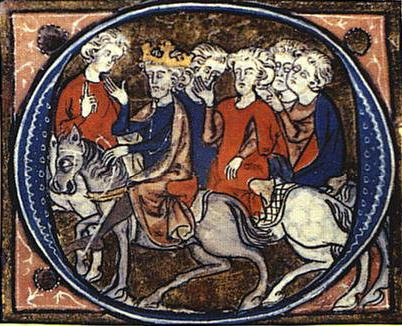

The Arthurian Legend and British Literature
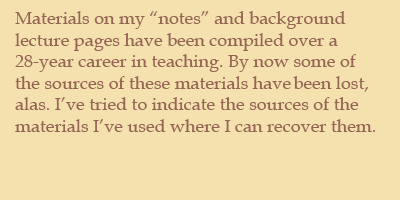
An excellent set of web links for the Arthurian legend is available at http://www.legends.dm.net/kingarthur/index.html.
A great deal of material on King Arthur is available from a variety of online sources. Some very reputable material can be found at the Norton Anthology of English Literature online (NAEL): http://www.wwnorton.com/nael/middleages/topic_2/welcome.htm
The Arthurian Handbook edited by Norris Lacy and others is an excellent starting place for historical, background, and factual information on Arthur.
Historical Arthur
"Arthur and his knights, although believed by most medieval people to be historical, are almost entirely products of legend and literature, made up by many authors writing in different genres, beginning not long after the fifth and early sixth centuries, the time when he supposedly lived, and culminating with Sir Thomas Malory's Morte Darthur in the latter part of the fifteenth century, " according to the Norton Anthology of English Literature. The Middle Ages apparently agreed with Sir Winston Churchill that the story of King Arthur "was all true, or it was meant to be, and more and better besides." Like stories of Davy Crockett or George Washington, what the real man did were almost not as important as what people came to believe Arthur had done—and that is the source of his great power as a legend in British literature.
The NAEL points out that "the man who inspired the Arthurian legend would have been a Briton, a leader of the Celtic people who had been part of the Roman Empire and had converted to Christianity after it became the official religion of Rome. As the Romans pulled out of Britain, the native Britons were making a temporarily successful stand against the Anglo-Saxon invaders who had already occupied the southeastern corner of Britain. Archaeology, epigraphy, and oral tradition suggest that somewhere in the years around 500 C.E., a charismatic local leader arose who organized British defenses against the invading Saxon tribes. Whatever his actual name was—and there is a LOT of debate about that—he has come down to us as "Arthur."
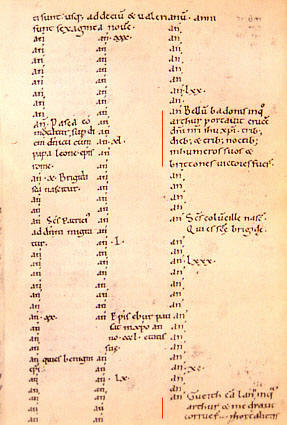
NAEL continues, "Arthur was never a 'king'; more likely, he was a leader of the native British resistance to the Anglo-Saxons. In the Welsh elegiac poem Y Gododdin, composed ca. 600, a hero is said to have fed ravens with the corpses of his enemies, 'though he was no Arthur,' indicating that the poet knew of an even greater hero by that name. According to a Latin History of the Britons around the year 800, ascribed to Nennius, "Arthur fought against the Saxons in those days together with the kings of Britain, but he was himself the leader of battles." Nennius names twelve such battles, in one of which Arthur is said to have carried an image of the Virgin Mary on his shoulders (or on his shield—the two words are closely related). The Latin Annals of Wales (a chronicle copied ca. 950) has an entry for the year 516 C.E. concerning 'the Battle of Badon, in which Arthur carried the Cross of our Lord Jesus Christ on his shoulders for three days and three nights, and the Britons were victorious.' So we can see that both writers of histories and the keepers of chronicles started to incorporate the mythic events of the Arthurian legend as if they were historical fact."
Furthermore, "Not until the twelfth century, though, did Arthur achieve a quasi-historical existence as the greatest of British kings. The new Norman kings of France, eager to legitimate their claims to the throne of England, were particularly interested in early histories of England that featured their ancestors—and a particularly ambitious and creative monk, Geoffrey of Monmouth, seized on the legends of Arthur and embedded them into other legendary tales to create The History of the Kings of Britain (1137) which featured Arthur as the greatest king of legendary England—and conveniently, as an ancestor of the Angevin rulers of England. His panegyric (work in praise of a ruler) was wildly popular and was quickly adapted into the vernaculars by Wace and Layamon, among others. At the same time, Arthur was flourishing in Welsh folktales as a fairy-tale king, attended by courtiers named Kei (Kay), Bedwyn (Bedivere), and Gwalchmai (Gawain). French writers, however, decided that such a great king must have a court—and created the "romance" side of the Arthurian story, featuring (of course French) knights like Yvain, Gawain, and their greatest creation, Lancelot. Drawing on a scholarly and slightly satiric tradition codified by Andreas Capellanus, these romances involved fin amor—refined or noble love—what later scholars call, inaccurately, 'courtly love'." [End of NAEL]
Romance Arthur
Arthur and his court, as exemplars of the new philosophy of chivalry and fin amor, quickly eclipsed the court of Charlemagne as the most popular storytelling material of the twelfth and thirteenth centuries. The idea of fin amor, what 19th century scholars renamed "courtly love," seems to have had its home in the circles around Eleanor of Aquitaine and her descendants, and is codified in Andreas Capellanus' De Amore, which sets out the rules for male/female engagement in this milieu and then provides a savage critique of it. The major figure in the embellishment of Arthurian romance is Chrètien de Troyes. Writing primarily in the court of Eleanor of Aquitaine's daughter Marie, Countess of Champagne, in the last three decades of the twelfth century, Chretien established the importance of Arthur’s knights and probably drew both the Grail legends and Tristan legends into the cycle as well. The new genre of romance focused not only on the exploits of this new knightly class fighting in wars and jousts or battling against monsters and supernatural enemies but also on the trials and fortunes of love and on the importance of personal, as opposed to feudal, bonds. His stories are aimed at mixed aristocratic audiences of men and women. Chrètien’s contemporary, Marie de France, assumes that her audience of noble readers understands the entire royal French culture of the Arthurian court. Her lais critique the whole idea of fin amor, and, especially in Lanval, ask readers to think about the values and views of women and men that such romances endorse.
The NAEL notes that "In the thirteenth century, a group of French writers produced what modern scholars refer to as the Arthurian Vulgate Cycle, in prose. This consists of a huge network of interlocking tales, featuring hundreds of characters. The Vulgate Cycle presents a darker side to Arthur and to the Round Table as a center of courtesy and culture." They attempt to cover the full history of Arthur, from the pre-history of the Holy Grail and the politics attending Arthur’s birth, through all his and his knights’ adventures, the quest for the Holy Grail, and Arthur’s eventual though ambiguous passing.
 "In
romance, both Arthur's role and his character undergo changes inconsistent with
his reputation as a great warrior. His court continues to be the center from
which the adventures of his knights radiate, but Arthur himself becomes
something of a figurehead, someone whom French scholars refer to as a roi
fainéant — a do-nothing king — who appears weak and is ruled and sometimes
bailed out by one of his knights, especially by his nephew Sir Gawain"
(NAEL). There
are practical reasons for this: when a king fights a battle there is usually
evidence of it. It’s easier to have the king stay home and have the knights go
out and fight—fewer messy historical questions, and more possibilities for
spin-offs and sequels (think the Star Wars novels). A
chronology of the Vulgate evolution is found at
http://faculty.arts.ubc.ca/sechard/344chron.htm.
"In
romance, both Arthur's role and his character undergo changes inconsistent with
his reputation as a great warrior. His court continues to be the center from
which the adventures of his knights radiate, but Arthur himself becomes
something of a figurehead, someone whom French scholars refer to as a roi
fainéant — a do-nothing king — who appears weak and is ruled and sometimes
bailed out by one of his knights, especially by his nephew Sir Gawain"
(NAEL). There
are practical reasons for this: when a king fights a battle there is usually
evidence of it. It’s easier to have the king stay home and have the knights go
out and fight—fewer messy historical questions, and more possibilities for
spin-offs and sequels (think the Star Wars novels). A
chronology of the Vulgate evolution is found at
http://faculty.arts.ubc.ca/sechard/344chron.htm.
"The very idea of Arthurian chivalry as a secular ideal undergoes a critique, especially in the Vulgate Cycle. While for the aristocracy Arthur's reign continued to provide an ancient model of courtesy, justice, and prowess, as it does in Deschamps's ballade on the Nine Worthies, moralists and satirists pointed out, with varying degrees of subtlety, how far Arthur and his knights fall short of the highest spiritual ideals. Sir Lancelot's adultery with Arthur's queen became an especially troubling factor" (NAEL).
"The legendary king of the Celtic Britons and his nephew were eventually adopted as national heroes by the English, against whose ancestors Arthur and Gawain had fought. A giant Round Table was constructed and displayed at Winchestor; the monks of Glastonbury made a small fortune showing off his supposed tomb; and English kings proudly included Arthur’s name and coat of arms in their family trees. That is how they are presented by William Caxton in the
Preface to his edition of Malory's Morte Darthur in 1485, the same year in which Henry Tudor, who thanks to his Welsh ancestry made political capital of King Arthur, became Henry VII of England." Malory’s book, of course, is more problematic, as the writer was full of the political worries of his time and yearned nostalgically for a legendary past in which kings were kings and the realm was strong. Malory's work stands as one of the finest examples of the Mirror for Magistrates genre, in which the rise and fall of exemplary political figures is used as a tool both to critique the current political situation and to instruct future rulers on how to avoid the mistakes of the past. NAEL concludes that "Caxton valiantly, and perhaps somewhat disingenuously, seeks to refute the notion, "that there was no such Arthur and that all such books as been made of him been but feigned and fables." Yet even after Arthur's historicity had been discredited, his legend continued to fuel English nationalism and the imagination of British writers." The following chronology provides a selected overview of historical events and Arthurian texts:Chronology (source: NAEL)
E = English, F = French, L = Latin, W Welsh
| Date | Historical Events | Texts |
| c. 450–525 | Anglo-Saxon Conquest | |
| c. 600 | Y Goddodin (W) Earliest Reference to Arthur | |
| c. 800 | Nennius, History of the Britons (L) | |
| c. 950 | Annals of Wales (L) | |
| 1066 | Norman Conquest | |
| c. 1136 | Geoffrey of Monmouth, History of the Kings of the Britons (L) | |
| 1154–89 | Reign of Henry II | |
| 1155 | Wace, Roman de Brut (F) | |
| c. 1160–80 | Romances of Chretien de Troyes (F); Lais of Marie de France (F) | |
| c. 1190 | Arthur's ‘grave’ dug up at Glastonbury | |
| c. 1200 | Layamon, Brut (E) | |
| 1215–35 | Arthurian vulgate prose romances (F) | |
| 1327–77 | Reign of Edward III | |
| 1337 | Outbreak of Hundred Years' War | |
| c. 1343 | Birth of Chaucer | |
| c. 1380 | Sir Gawain and the Green Knight (E) | |
| c. 1394 | Chaucer, Wife of Bath’s Tale (E) | |
| 1400 | Death of Chaucer | |
| c. 1435 | Book of Margery Kempe | |
| 1454–85 | Wars of the Roses | |
| c. 1469–70 | Malory completes Morte Darthur in prison | |
| 1485 | Henry VII first Tudor king | Morte Darthur printed by Caxton |
The following historical facts are taken from http://mockingbird.creighton.edu/english/fajardo/teaching/eng340/marie_de_france.htm:
·
"earliest French woman poet, probably active in England." The surname "de France" probably means that she comes from the area of France around Paris, probably the Isle de France in Paris. Most of the early manuscripts of her work are English in origin; remember that this was a world where there was a lot of aristocratic movement between England and France.· "
perhaps a half sister of Henry II ((r. 1154-1189); she is surmised by many to be Marie, daughter of Geofrey IV of Anjou who was the father of Henry II"; see the Angevin genealogy·"
lai, poetic and musical form popular among the poets (trouvères) of northern France; long poems with rhymed stanzas of 6-16 lines, 4-8 syllables/line. Marie's are octosyllabic (8 syllables per line)". There is, however, no evidence in the surviving manuscripts that Marie's Lais were sung.·
"Breton lai (or lay) short, rhymed romance supposedly practiced by Breton storytellers; often include elements of the supernatural, chivalry, influence of classical and Celtic mythology (land of faerie). Marie's Breton lai was a short romance, between one hundred and a thousand lines, unlike the courtly romances which stretched to several thousand lines." The most famous Breton lai in English is Chaucer's Franklin's Tale.· "Lais of Marie de France (c. 1160), twelve verse narratives in French (Anglo-Norman) language; octosyllabic couplets; dedicated to the "noble" king (likely Henry II)". These provide a kaleidoscopic view of the relationships possible between aristocratic men and women in the late twelfth century, with no two presenting exactly the same point of view.
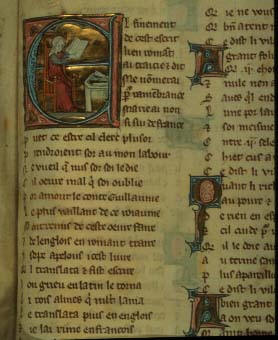 The
Longman Anthology website says that "Marie
de France's identity remains obscure, but it is clear that she was a woman of
French origin writing in England in the later decades of the twelfth century,
widely educated, and in touch with the royal court. She dedicates her book of
Lais to a "noble King" who was probably Henry II, and she may have been his
kinswoman, possibly an illegitimate half-sister. Marie's works draw into that
courtly culture the languages and traditions of the English and Celtic past. She
rewrote a Latin narrative about the origin of "Saint Patrick's Purgatory" and
the adventure of an Irish knight there; and she retold the fables of Aesop using
an English translation that she attributed to King Alfred. The Lais, she says,
came to her through oral transmission, and she connects them with the Bretons."
(Page seems to have disappeared but I retrieved it thru the Wayback Machine at
http://web.archive.org/web/20060216193435/http://occawlonline.pearsoned.com/bookbind/pubbooks/damrosch_awl/chapter2/
The
Longman Anthology website says that "Marie
de France's identity remains obscure, but it is clear that she was a woman of
French origin writing in England in the later decades of the twelfth century,
widely educated, and in touch with the royal court. She dedicates her book of
Lais to a "noble King" who was probably Henry II, and she may have been his
kinswoman, possibly an illegitimate half-sister. Marie's works draw into that
courtly culture the languages and traditions of the English and Celtic past. She
rewrote a Latin narrative about the origin of "Saint Patrick's Purgatory" and
the adventure of an Irish knight there; and she retold the fables of Aesop using
an English translation that she attributed to King Alfred. The Lais, she says,
came to her through oral transmission, and she connects them with the Bretons."
(Page seems to have disappeared but I retrieved it thru the Wayback Machine at
http://web.archive.org/web/20060216193435/http://occawlonline.pearsoned.com/bookbind/pubbooks/damrosch_awl/chapter2/
medialib/defrance.html.) The Longman Anthology website continues,
"Writing a generation after Geoffrey of Monmouth and not long before Gerald of Wales, Marie brings a quite different and rather critical set of preoccupations to her Arthurian story. She opens her tale with a realistic and admirable occasion of male power and strong kingship: Arthur's battle for territory and his reward of faithful vassals. A bleaker side of that courtly world, and perhaps of Marie's own, is also implicit, however. With a terseness and indirection typical of her lais, Marie shows women as property in the king's gift, knights forgotten when their wealth runs out, and the perversion of judicial process. It’s worth comparing the world of Lanval with what we saw in Old English poetry of the relation of lord and retainers, and the connections between men and women."
"Marvels and erotic desire dominate her tale, though, and women's power, for good or ill, is its primary motivating force. Arthur's unnamed queen, in a hostile portrait of adulterous aggression and vengeful dishonesty, nonetheless manages to manipulate Arthur and his legal codes when Lanval rejects her advances. The queen is countered by Lanval's supernatural mistress, the fée, who commands luxurious riches that dwarf Arthur's; she rescues Lanval by being an unimpeachable legal witness in his defense. Indeed, she arrives on her white palfrey as the moment of judgment nears, almost like a knightly champion in a trial by battle. In a total reversal of convention, once she frees her love, she rides off with him into the sunset—only it’s the man on the back of the horse. Lanval vanishes into a timeless world of fulfilled desire and limitless wealth that has analogies in much older Celtic tradition. This closing scene defies the reintegration of male courtly order that is typical even in the erotic romances of Marie's contemporary Chrétien de Troyes. "
"The realm of eroticism and women's power in Lanval, though, is not automatically any more virtuous or stable than the ostentatious wealth and corruptible law of the world of Arthurian men. If Lanval's mysterious lady is beautiful and generous, she also takes his knightliness from him. Lanval is last seen riding behind the lady, and not on a warhorse but on a palfrey. Guinevere swiftly reduces Arthur to a weak and temporizing king. And in her initial explosion after Lanval rejects her, Guinevere accuses him of homosexuality. For all its absurdity, the moment articulates unnerving implications of the profound bonds among men in the Arthurian world, implications that could interrupt genealogical transmission of wealth and power. Marie's Guinevere again voices fears the tradition has left unsaid. "
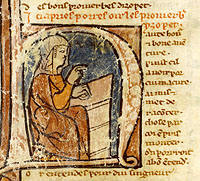 "Marie
de France may be trying less to propound a critique of the received stories of
Arthur than to recall her readers' attention to elements that tradition has left
aside, as she suggests in her prologue. Some of this is no more troubling than a
delightful fantasy of wealth and pleasure, outside time and without
consequences. Other elements imply, with startling economy, forces that (in the
hands of later romancers) tear the Arthurian world to pieces."
(End of Longman)
"Marie
de France may be trying less to propound a critique of the received stories of
Arthur than to recall her readers' attention to elements that tradition has left
aside, as she suggests in her prologue. Some of this is no more troubling than a
delightful fantasy of wealth and pleasure, outside time and without
consequences. Other elements imply, with startling economy, forces that (in the
hands of later romancers) tear the Arthurian world to pieces."
(End of Longman)
This is only one of Marie’s dozen lais; the others in her collection (including one on the Tristan legend) view love from other points of view, rendering a very kaleidoscopic picture of the relationships of men and women, of individuals and society, and of power and authority in her time.
Sources: http://www.wwnorton.com/nael/middleages/topic_2/welcome.htm
http://occawlonline.pearsoned.com/bookbind/pubbooks/damrosch_awl/chapter2/medialib/defrance.html (retrieved from www.archive.org)
If you want to read two of Marie's Fables, which seem to anticipate Chaucer's fabliaux, you can find them on the Harvard Chaucer pages at http://www.courses.fas.harvard.edu/~chaucer/special/litsubs/fabliaux/mari-fab.html
![]()
Questions for discussion on Lanval drawn from http://merlin.capcollege.bc.ca/fahlmanreid/lanval_questions.htm
1. Why do you think so much importance is placed on gift giving and largesse, both from the King's court, from the fairy, and from Lanval? What role do you think gift giving and largesse had in this economy? Is it similar to the world of Old English poetry?
2. Note the attitude in the poem toward envy and slanderous gossip. How do you account for it? What light does it give to the relationships of a 12thC court? To the importance of reputation? Later, look for a similar motif in the Morte Darthur.
3. When the Queen professes her love for Lanval, on what grounds does he refuse her? Is there a conflict between his feudal oath and his courtly honour? When the Queen accuses Lanval of homosexuality, and when he in turn insults her beauty, how do we read the plot? How do we see again the importance of reputation? Is the King, as well, guilty for his mistreatment of Lanval?
4. Note the reversal of the motif of a damsel in distress rescued by a knight. Instead here, as in "The Wife of Bath's Tale," the motif is reversed. What might the attraction of that be? How does the fairy contrast with Guenevere?
5. What is the significance of the other knights taking Lanval's part against the court and King during Lanval's trial?
6. Is Lanval faithless in breaking his pledge to the fairy? Why does she not keep her vow and abandon him for breaking his oath?
7. What elements in the courtship of the fairy and Lanval, and in the course of their affair, fit with Andreas Capellanus' list of Rules of Courtly Love?